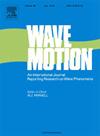Eulerian contributions to the particle velocity in Stokes and Gerstner waves
IF 2.5
3区 物理与天体物理
Q2 ACOUSTICS
引用次数: 0
Abstract
For inviscid periodic wave motion, we derive a novel expression in Lagrangian variables for the Stokes drift, which is valid for rotational as well as irrotational waves. The derivation confirms that the Lagrangian mean velocity can be expressed as the sum of the Eulerian mean velocity and the Stokes drift. However, from the Stokes drift part of this expression, we find that the rotational Gerstner wave has a non-zero Stokes drift. Since the Lagrangian mean velocity is zero for this particular wave, we obviously must have a non-zero Eulerian mean velocity in this case, cancelling the Stokes drift. To discuss this problem in detail, we return to the basic kinematics of periodic wave motion in fluids. We avoid time averaging and consider the classic problem of how the Lagrangian particle velocity develops in time, resulting in a Eulerian velocity (expressed in Lagrangian variables) plus the Stokes velocity. We discuss the implication for irrotational deep-water Stokes waves and rotational Gerstner waves. It is demonstrated that the Eulerian velocity, expressed in Lagrangian variables, is different for the two wave types. This explains why the Lagrangian mean velocity in the Stokes wave is equal to the Stokes drift, while it is zero for the Gerstner wave.
欧拉对斯托克斯波和格斯纳波中粒子速度的贡献
对于无粘周期波动,我们导出了一个新的斯托克斯漂移的拉格朗日变量表达式,该表达式适用于旋转波和无旋转波。推导证实了拉格朗日平均速度可以表示为欧拉平均速度和斯托克斯漂移之和。然而,从表达式的Stokes漂移部分,我们发现旋转Gerstner波具有非零Stokes漂移。由于这个波的拉格朗日平均速度为零,在这种情况下,我们显然必须有一个非零的欧拉平均速度,来抵消斯托克斯漂移。为了详细讨论这个问题,我们回到流体周期波动的基本运动学。我们避免时间平均,并考虑经典的拉格朗日粒子速度如何随时间发展的问题,导致欧拉速度(以拉格朗日变量表示)加上斯托克斯速度。讨论了非旋转深水Stokes波和旋转Gerstner波的含义。证明了用拉格朗日变量表示的欧拉速度对于两种波类型是不同的。这就解释了为什么斯托克斯波的拉格朗日平均速度等于斯托克斯漂移,而格斯纳波的拉格朗日平均速度为零。
本文章由计算机程序翻译,如有差异,请以英文原文为准。
求助全文
约1分钟内获得全文
求助全文
来源期刊

Wave Motion
物理-力学
CiteScore
4.10
自引率
8.30%
发文量
118
审稿时长
3 months
期刊介绍:
Wave Motion is devoted to the cross fertilization of ideas, and to stimulating interaction between workers in various research areas in which wave propagation phenomena play a dominant role. The description and analysis of wave propagation phenomena provides a unifying thread connecting diverse areas of engineering and the physical sciences such as acoustics, optics, geophysics, seismology, electromagnetic theory, solid and fluid mechanics.
The journal publishes papers on analytical, numerical and experimental methods. Papers that address fundamentally new topics in wave phenomena or develop wave propagation methods for solving direct and inverse problems are of interest to the journal.
 求助内容:
求助内容: 应助结果提醒方式:
应助结果提醒方式:


